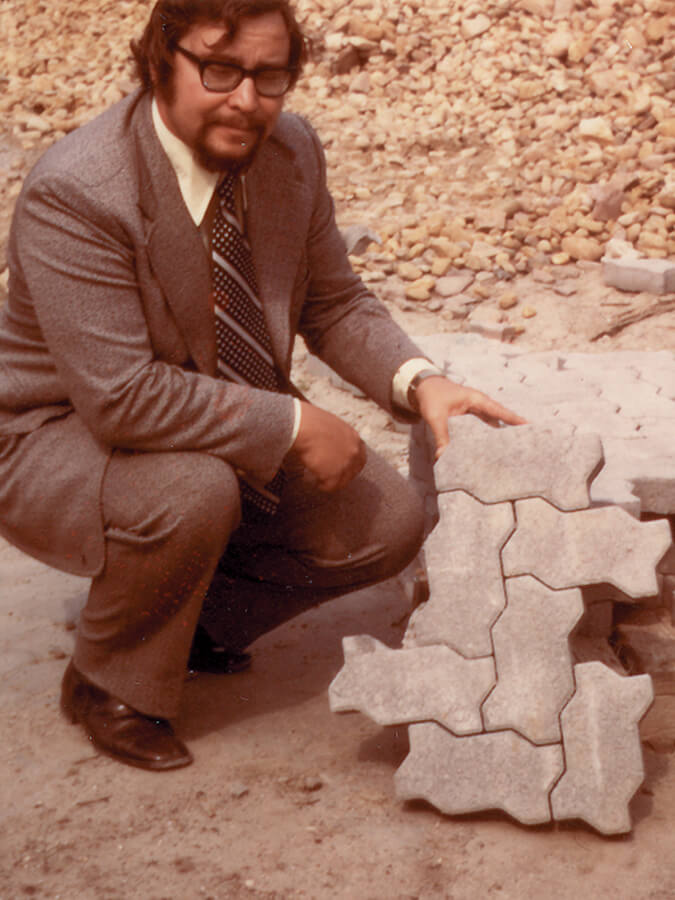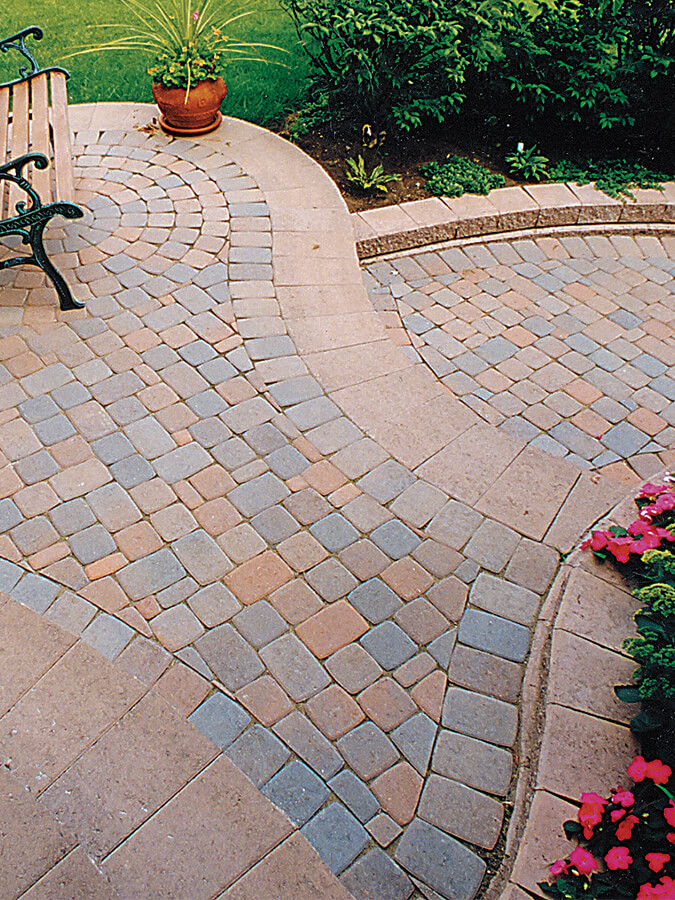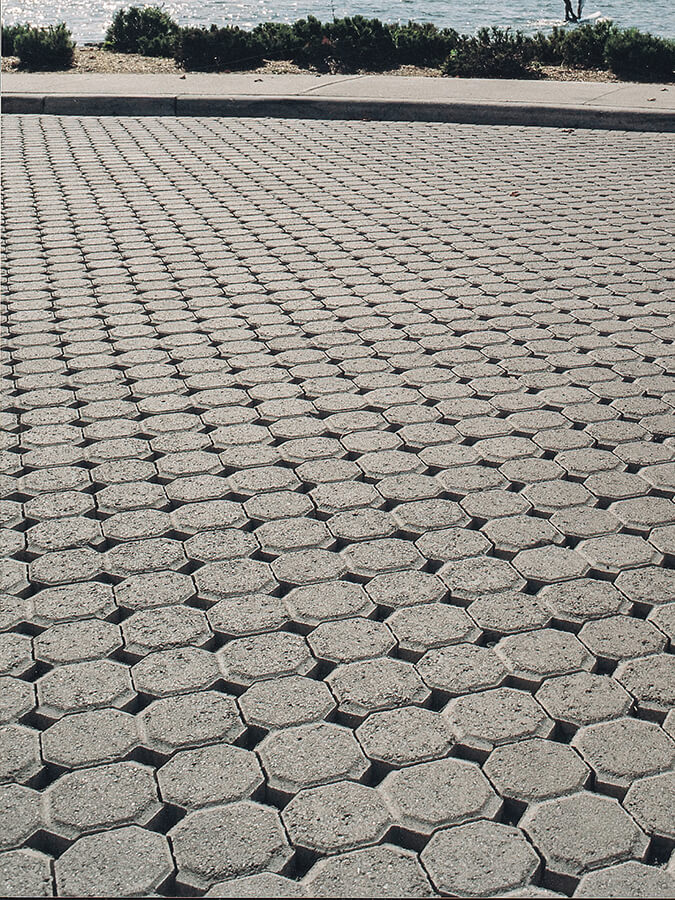May 3, 2021
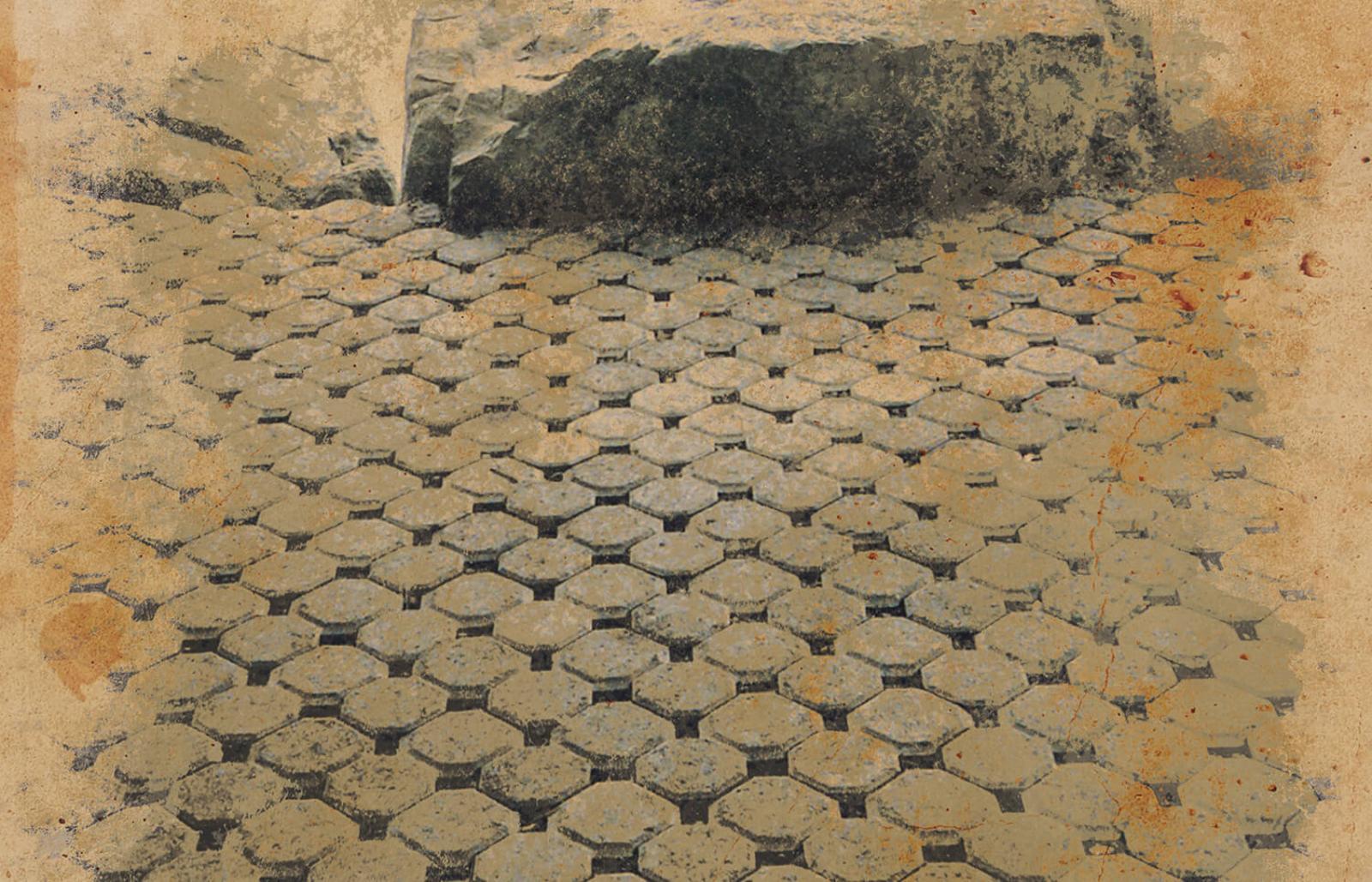
The history of pavers
Looking back on the evolution of hardscaping in Canada
BY JORDAN WHITEHOUSE
In the early 1970s, a young man named Ed Bryant was building a ski chalet in Horseshoe Valley, Ont., when he hired a Swiss stonemason to construct a fireplace. At one point, the stonemason showed Bryant a brochure from his father’s company in Zurich which sold paving stones. Bryant was impressed, having never really seen anything like them in North America. “This is a heck of a system,” said Bryant. “How much would it cost to put this in my driveway?”
“It doesn’t matter,” the stonemason replied. “You can’t buy it here. I came over here to install paving stones, but nobody in North America makes them.”
Bryant smelled an opportunity, and soon he travelled to Zurich to meet the stonemason’s father. Long story short, Bryant convinced the patent holder to grant him a licence to produce UNI-Stone in Ontario and he bought a machine that could produce 14 stones at a time. By 1972, Bryant had set up a company in Barrie, Ont., that would eventually be called Unilock. The first permanent concrete paver manufacturing factory in North America was born.
“I pictured us paving all of Ontario with paving stones,” remembered Bryant years later.
It was a bold dream, but it wasn’t without precedent. After the Second World War, Holland began a massive reconstruction effort that replaced many streets with concrete paving stones. By the 1960s, German manufacturers developed efficient paving stone machines and were selling an estimated 10 square feet of paving stone per capita. And today, while Ontario might not be entirely covered in paving stones, pavers have certainly become ubiquitous across the province, not to mention the country and the world. Some estimates suggest 1,000 pavers are now made every second on the planet. In 2020, the Interlocking Concrete Pavement Institute (ICPI) reported there were over 100 manufacturing companies in Canada and the U.S.
Bryant passed away on Jan. 28, 2021, at the age of 85 at his home in Horseshoe Valley. But as Landscape Ontario Executive Director Tony DiGiovanni put it recently, Bryant’s legacy lives on. “How many thousands of people have been positively affected by the gardens and landscapes that were built with elements that Ed first brought to North America,” DiGiovanni asked. “How many businesses and careers were propelled forward? How many other companies were elevated? How many people were inspired by his dreams, attitudes, energy, and actions?”
The early years
While Unilock may have been the first, there were soon a handful of other paver manufacturers and contractors in Ontario. Many of the early projects were for the commercial and industrial sectors. A project at the Toronto Metro Zoo was one of Unilock’s first, followed by the driveway of the iconic Toronto Fire Station 312 between Bay and Yonge Streets (Unilock replaced the original installation there about four years ago).One of the early contractors was Gosnell Paving, in London, Ont., which was started in 1979 by landscape architect Ron Koudys and a few others. In 1982, Gosnell was selected to design North Bay, Ontario’s downtown, and they proposed to do it with paving stones. It would be the first downtown in North America surfaced entirely with paving stones, but as Koudys remembers, there was a lot of skepticism.
“So, we did an interlocking paving stone seminar in Toronto and we brought some of the top people from South Africa, Australia, and Europe to talk about their experience,” Koudys said. “As a result, it built some confidence in the North Bay engineering department, and eventually they said, ‘Yes, let’s go.’” Recently, Koudys and a partnering engineering firm won the bid to replace North Bay’s downtown once again.
Around the time Gosnell Paving got started, a recession hit, and that put the brakes on most of the commercial work for those first paving stone companies. In response, they started targeting homeowners and began marketing pavers as the ideal solution for outdoor patios. Unilock invested heavily in TV advertisements, and it paid off.
“That really helped save the company,” says current sales manager Derek DeCooman. “And I imagine what attracted those first customers was the point load system and the fact that you’d be replacing a heavy-duty asphalt application a lot sooner than you would an original segmental concrete paver.”
At the same time, the OPEC oil crisis was raging, which drastically drove up the price of asphalt. All of a sudden, concrete paving stones became a lot more financially competitive.
The colours and styles of those first stones were quite limited. Initially, they came in one colour: natural, and one shape: rectangular. But soon colours like red, charcoal, and terra cotta were introduced. More blended colours were introduced in the 1980s, and by the end of the decade, tumbled stone came into play, which gave the paver a more rough, natural look.
Ron Koudys might have been the first to suggest tumbled stone in Canada. “I remember a sales rep from Adair Marble visiting me who saw the popularity of interlocking paving stones. They wanted to cut marble for paving, but I said it looks too slippery and precise, and that they should rough it up in a cement mixer or something and tumble it around and knock the corners off of it. So that’s what they did and I used it. The interlocking paving guys saw what they were doing and they said, ‘Oh, we can do that too.’ So, I’d like to lay claim to inventing that,” Koudys laughed. “Who knows, though.”
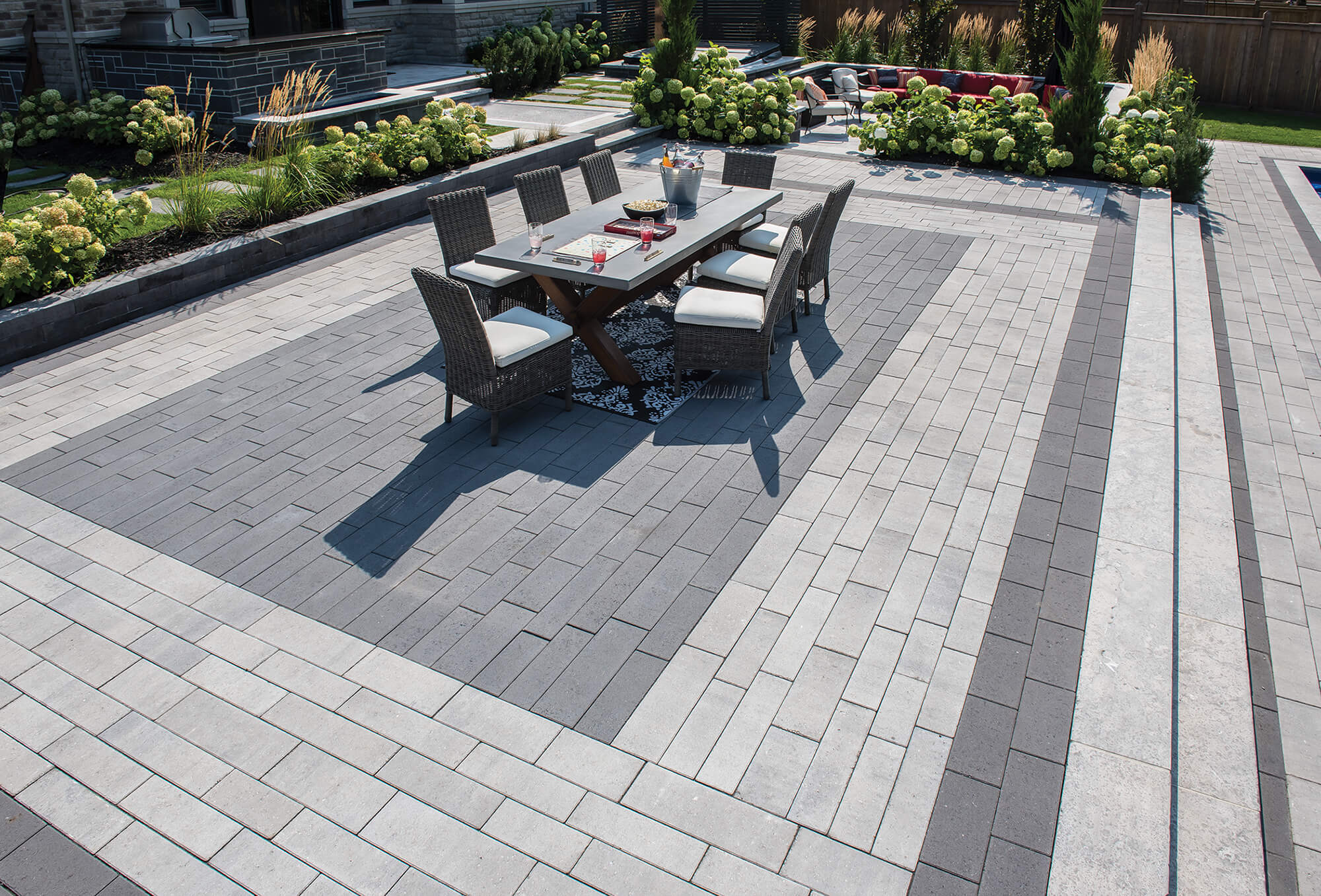 Contemporary landscape featuring Oaks Landscape Products. Onyx Presidio pavers.
Contemporary landscape featuring Oaks Landscape Products. Onyx Presidio pavers.1990 to today
Whoever invented it, the tumbled paver became extremely popular by the 1990s. “It was like when Dodge came out with the minivan; you couldn’t keep it in stock,” says DeCooman.The industry also began growing exponentially at this time, particularly in southwestern Ontario, where a significant amount of high-quality aggregate is found. Soon, companies used that success to expand south of the border. Unilock, for instance, opened production facilities in Buffalo, Chicago, Detroit, New York, Boston, and Cleveland.
There were challenges, however. Some paving stones got a bad reputation because of weeds growing between them or ants building sandhills in the joints, or ruts developing on driveways. This was due to a number of factors, including poor materials, installation or maintenance.
The production of tumbled stone was also a challenge for workers, says Brampton Brick General Manager Marcus Poirier. “It was a very manual and labour-intensive process where people were double-handling the product — first with curing it, then with tumbling and sorting it. Often people would be hurting their backs.”
By the early 2000s, as new technologies and methods were developed in North America or imported from Europe, many of these challenges became things of the past. Polymeric sand improved, preventing ant and weed issues, and paver manufacturers began implementing face-mix technology, which not only made the paver structurally stronger, but also made the colour and finish last longer. And manufacturing techniques were developed to reduce the toll on workers while still giving pavers that distressed, natural look.
 Contemporary landscape featuring Unilock products. Granite Fusion Beacon Hill Smooth paver with U-Cara firepit and wall.
Contemporary landscape featuring Unilock products. Granite Fusion Beacon Hill Smooth paver with U-Cara firepit and wall.Today, those natural designs are still popular, but since about 2014, the biggest trend has been smooth, large slabs that work with recent home design styles that are clean, contemporary, and minimal, says Poirier. “And people want deep, dark blacks; they want really light white colours. And rather than having blends of different tones as they would have in the past, they want each individual paver to be more monotone.”
DeCooman has seen the same, but he also says smaller sets are making a bit of a comeback. “We’re doing some unique things with banding and fanning, and while everyone likes the large, clean, contemporary look, there are still some who want to capture that robust, historic cobble or reclaimed brick look.”
Plus, says Koudys, the environmental movement has made city dwellers, in particular, think harder about permeable products. “The problem was that [cities] built their whole subdivision drainage patterns around storm ponds, and now they’ve realized that storm ponds aren’t the solution and cities are looking instead at ground infiltration closer to source. We’ve had a heck of a time trying to convince city engineers and conservation authorities to use permeable paving, but now all of a sudden they’ve taken a 180 and are finally asking for it.”
Where will the paving stone industry be 50 years from now? No one has a crystal ball. But we do know it will be fascinating to watch new trends and styles emerge. And even more importantly, to see the way technological and engineering innovations continue to shape the industry.
And to think it all started by "happen-chance," as Bryant used to put it. "It happened to happen," he said in a video before his passing. "I happened to see that brochure. I happened to see that product. And I happened to think, 'That’s a damned good product.'"
